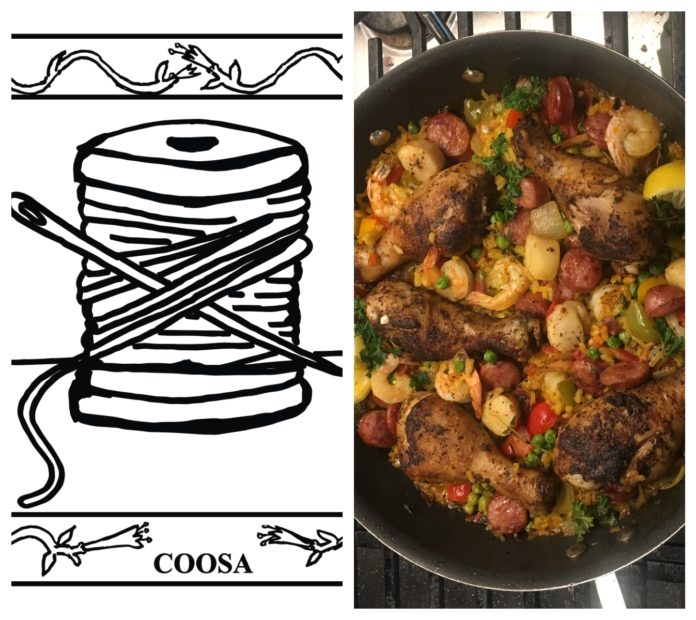
The Cullman Tribune is celebrating the Alabama Bicentennial (1819-2019) with statewide field reporting by Alabama Master Gardener/Botanical Artist Ben Johnson South. This year-long feature, “The 67-County Alabama Garden Party,” will spotlight different counties each week. Each county will get its own “quilt block,” along with a historical profile, and we’ll share a recipe specific to the area. At the end of the year, all 67 counties will be put in a book to commemorate the Bicentennial.
Coosa County
“Silver Threads and Golden Needles” should be on your Alabama road trip soundtrack when you come to Coosa County. From the time the county was established in December 1832, thread, fabrics and sewn goods have made this part of the state, “The Textile Capital.”
The word “Coosa” derives from a town of the Creek tribe which originally inhabited the land and from the Coosa River which forms one of the borders of the county. Even before statehood, during Colonial and Territorial times, textiles were the leading trade item between the Native Alabamians and the British and Scottish explorers. The Creeks eagerly exchanged deerskins and furs, which were all the vogue in western European markets, for lightweight British wools, cotton calicos, Irish linens, threads and needles.
Any Anglophiles reading this may feel a bit of pride that British textiles and goods were preferred by Alabama’s native tribes over similar items produced by the French and Spanish because of the superior workmanship and durability. (Source: Alabama Heritage Magazine, Fall, 2018)
An advertisement in an Alabama newspaper from 1820 trumpets these textiles for trade: “Superfine cloths, blankets, flannels, plain and furniture calicos, Irish linen, Irish sheeting and diapers, domestick ginghams and checks, bed ticking, napkins, black silk Florentine, scarfs, shawls, vesting, white lace, silk and tabby velvets, bandanas, handkerchiefs, ribbons, Madras, muslins, lambswool, buckskin and dogskin gloves, umbrellas and parasols…and more.” Oh my, we Alabamians were desperate for some finery in those roughhewn, frontier times.
By the end of the 20th century, Coosa County led the state in textile production.
Here are other positive and pleasurable ways PLANTS + PEOPLE are threaded together in Coosa County:
*COOSA COUNTY FARMSTANDS- Betty Wilson (Kellyton); Joe and Nancy Harris (Rockford)
*COOSA COUNTY BLUEBERRIES- Jack’s Blueberry Hill (Equality); Oakachoy Blueberry Farm (Equality) which also grows assorted vegetables, plants and hanging baskets; Roger’s Berry Farm (Goodwater)
*HATCHETT CREEK- This beautiful, wooded area is where I would bring a landscape painter or photographer to capture a panoramic perspective. The creek originates near the town of Goodwater and runs for 40 miles; it is secluded and heavily forested offering stunning scenery for those hiking and canoeing. Rare Cahaba lilies grow in the shallows and on creek banks and are breathtakingly beautiful in bloom.
*FIVE STAR PLANTATION- Established as a hunting preserve in 1919, this destination attracting guests from every state in this country and internationally is for those who love outdoors and wildlife and thrill to see turkey, deer and quail in a natural habitat. The preserve is nestled among 5,000 acres of east-central Alabama’s broom sage fields, mixed hardwoods and longleaf pine forests.
*THE OLD ROCK JAIL- (Rockford) Completed in 1842 and now a museum, it is the oldest extant stone jail in Alabama; the building is 20×40-feet with a stone chimney on one end. Enjoy special displays on textile history and Coosa County cotton farming.
*PLANTING AN IDEA- In the early days of Alabama statehood threads and fabrics were colored by using plant dyes. A community garden for plant dyes which could thrive in Coosa County might include: carrots, beets, grapes, strawberries, blueberries, spinach and kale. An exotic plant to grow both for seasoning and dying is Crocus sativus, commonly known as “saffron crocus.” Saffron, which derives from the stigma of this plant, is one of the world’s most expensive spices and has been for centuries.
Y’all come to Coosa County on your 67-County Alabama Garden Party tour! Many thanks to Laurie Johnson for her original recipe with spiced with saffron threads.
Coosa County Alabama Paella with Chicken, Seafood, Sausage and Garden Vegetables (~ 6 servings)
SAFFRON THREADS, the bright yellow, aromatic spice threads from the Crocus sativus, MUST be used in paella, a delicious fusion of rice, meat, seafood and vegetables. Paella is considered the national dish of Spain, but we Southerners recognize the centuries-old, multicultural allure of blending these ordinary ingredients, which also star in our beloved Southern jambalaya, Chinese fried rice, Indian biryani and many others. In each recipe, regional spices and cultural cooking traditions transform common ingredients into unique taste sensations. In paella (translates to “pan”) familiar Alabama ingredients, sewn with the threads of saffron, yield a completely satisfying, one-pan family meal.
Ingredients in rough order of use:
- 1.5 lb. chicken pieces with skin on (Use legs and/or thighs because they stay moister.)
- 1 tbsp. each smoked paprika and dried oregano and 1/2 tbsp. each salt and black pepper (plus more later)
- 1/2 lb. large sea scallops (Press out excess moisture.)
- Olive oil
- 1 onion and about 1/2 each green, orange and red bell peppers, all coarsely diced
- 3 smashed garlic cloves, a handful of fresh minced parsley and thyme (Save some for garnish.)
- 2 Roma tomatoes coarsely diced or 1 regular sized can diced tomatoes, drained
- 2 cups long-grained rice (Traditional paella uses short-grained, but it can get gummy.)
- 2 “pinches” saffron threads – soaked to bloom in 1/4 cups warm water for about 10 minutes
- 4 cups chicken broth
- About 4 dried bay leaves
- 1/2 lb. medium to large Gulf Coast shrimp – veined and peeled
- About 1/2 package frozen green peas
- 1 fresh lemon for serving
Instructions:
- Coat chicken with smoked paprika, oregano, salt and black pepper and refrigerate for an hour. (or up to overnight) while prepping the other ingredients.
- Using a deep, heavy bottomed skillet with a lid, sauté sausage until browned and remove to a sheet pan to keep in a slightly warm oven. (heated to 200F and turned off).
- In same pan, cook chicken until done and browned, add oil if needed, remove to warming pan.
- If the scallops are large, give them a very quick sear in the pan and remove to warming pan.
- Add 2 swirls of oil and sauté onion and bell peppers until soft. Add garlic, parsley and thyme and cook until fragrant. Stir in tomatoes and more salt, pepper, paprika and oregano to taste.
- Add the rice and saffron water and stir fry until all the grains are well coated and hot.
- Stir in the chicken broth and the bay leaves (remove later). Reduce the heat and simmer uncovered and undisturbed for 15-20 minutes until the liquid is mostly absorbed by the rice.
- Gently fold in the seafood and peas and cook undisturbed for about 5 minutes. Place the cooked chicken and sausage on top, gently pressing into the rice mixture. Cover the pan and heat on low for another 5-10 minutes to finish. Ideally, the rice forms a light crustiness on the bottom yet remains fluffy and flavorful.
- Serve family-style, from the pan with a light squeeze of lemon juice and parsley to garnish.
Also, check out Alabama Bicentennial: 200 ways to save Alabama for the next 200 years.
Copyright 2019 Humble Roots, LLC. All Rights Reserved.




























